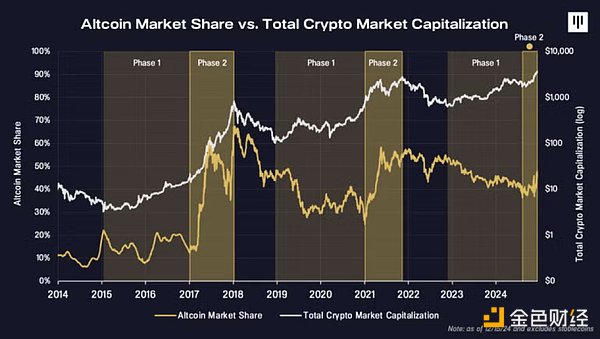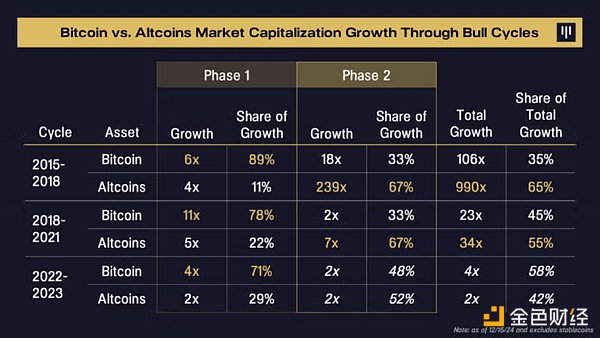Pantera Partners: Crypto Industry Events in 2024

Reprinted from jinse
12/18/2024·6MAuthor: Cosmo Jiang, Partner at Pantera Capital; Translated by: Golden Finance xiaozou
We believe this has been a very constructive year for the crypto industry, with significant progress in terms of price action, market structure milestones, and significant regulatory and political shifts. From the passage of the FIT21 bill, to the successful launch of ETFs, to the election of the first-ever U.S. president to support cryptocurrencies, we have seen the capital, innovation and regulatory environment once again be favorable.
The following is a review of the big crypto events in 2024.

After a strong 2023, prices continue to rise as the market predicts several positive catalysts in the first half of 2024:
- The launch of the highly anticipated Bitcoin ETF in January is the most noteworthy event. The ETF began to see strong inflows shortly after its launch, leading to strong price action throughout February and March.
- February saw a surge in on-chain activity, primarily meme coin trading activity on Solana, against the backdrop of a new wave of retail participation.
- Over the next month, a major Ethereum upgrade, EIP-4844, significantly reduced transaction costs for Ethereum L2s.
Then, as risk assets fell across the board in April, the market encountered some challenges. Headwinds have surfaced, mainly in the form of changes in macro expectations, and higher inflation data suggests that interest rates are likely to move higher in the long term. Additionally, the conflict between Israel and Iran has raised geopolitical concerns. The end of April ushered in Bitcoin’s third halving, but surrounded by these unfavorable factors, this halving event did not bring much short-term excitement.
In May of this year, we started to see the first signs of political bullishness for cryptocurrencies. It started when Trump turned to support cryptocurrencies in a speech on May 8. Some positive legislative developments soon followed, including House passage of the FIT21 bill and the surprise approval of an Ethereum ETF.
But the reality is that progress has been fitful and there are fewer tangible catalysts to get excited about after May. This continued and we saw significant pullbacks across asset classes throughout the remainder of the summer. Ethereum ETFs began trading in July, but they failed to serve as a positive catalyst for the market due to weak market conditions.
In September, driven by the Federal Reserve's first interest rate cut, the macro environment began to improve. Markets continue to rebound from the oversold conditions of the summer as expectations for the U.S. election increase and both parties begin to openly support cryptocurrencies.
On November 5, the results of the U.S. election came out, and the market began to operate at high speed.
Price surge after US election
Markets have been rising since the "U.S. election" with Republicans taking control of the presidency and both chambers of Congress in anticipation of pro-industry moves. We believe that the crypto industry and its supporters had a clear impact on the election. The new Congress is the most pro-crypto Congress we have ever seen, with a majority of House members and a majority of newly elected senators taking a pro-crypto stance. For the popular vote, the margin of victory was smaller than the estimated single-issue electorate encrypted electorate. In many ways, the digital asset industry could legitimately argue that this is the swing vote, and like pivot security in the capital stack, it could have huge sway in the future. An enthusiastic pro- crypto White House, coupled with supportive majorities in both chambers, should create the best environment for constructive crypto legislation.
Bitcoin has long benefited from a clear approach to how it can be used, taxed and regulated. This clarity sets it apart from other industries. It’s now a mouth-watering prospect that entrepreneurs looking to leverage tokens and blockchain to build serious value-added businesses may soon benefit from similar clarity, and we believe a wave of innovation should follow. While Bitcoin has taken up a large part of the discussion since the election, not much has changed with it, aside from the possible establishment of a strategic Bitcoin reserve in the United States. Everything could change meaningfully for other productive projects. In the long term, the passage of stablecoin and market structure legislation should have a much greater impact on altcoins than it does on Bitcoin.
As a result, retail capital’s re-participation in the broader cryptocurrency market has begun to take shape. Coinbase saw strong weekend trading volumes, as evidenced by a surge in the number of “last cycle coins,” or the most recognized and accessible coins on the retail distribution platform. As a result, Bitcoin’s dominance has seen a monthly decline for the first time in nearly two years. We are increasingly convinced that we are now closer to the “second phase” of the cycle, when long-tail tokens representing innovative value-creating blockchain solutions may begin to outperform.
Entering the second stage
We observe that bull market cycles have two distinct phases. The first phase is the early stages of a rally, when Bitcoin tends to outperform the rest of the market. The second phase is the late stage, when long-tail coins or “altcoins” tend to outperform the rest of the market.
We believe that the rest of the coins are now accelerating.

Notably, the performance of altcoins in the second phase was so large that altcoins outperformed Bitcoin throughout the first two cycles – non-Bitcoin tokens’ share of total market cap growth respectively are 65% and 55%. We are now seeing some early signs that we are in the second phase of the rise, with the US election being the catalyst for this phase.
Outlook

There are many reasons to be optimistic about the digital asset market. When I think back on the past few years:
– 2021 has been a booming time for innovation and excitement, with many people entering the cryptocurrency space for the first time.
– 2022 is a natural burst of speculative excess across all asset classes.
– 2023 is shaping up to be a year where the industry encounters headwinds – whether it’s rising system leverage and capital outflows, fading consumer interest, or regulators being forced to overreact to underreactions to the previous year’s excesses.
– 2024 is the year when headwinds turn into tailwinds. We're starting from a healthier position, with capital inflows starting (mostly from Bitcoin ETFs). User activity has begun to pick up, and more importantly, regulators are beginning to loosen their regulations and are being pushed back in court.
2025 is expected to be a year of tailwinds that will accelerate the industry’s growth:
– The election changed the paradigm of the blockchain industry. When you think about the reasons for rejection by potential investors and innovators, the answer is often a lack of regulatory transparency. This pessimistic situation may soon pass.
– Fundamentals will ultimately drive prices higher. Fundamentals, measured by on-chain activity and new innovations like AI agents and DePIN, are improving in real time. However, the price recovery of long-tail coins is still in its early stages.
– As digital assets become more mainstream, capital flows should improve. Bitcoin ETF issuance should continue to grow, and more ETFs may follow (such as Solana). Institutional allocators and sovereign entities are reaching out to us because they can no longer ignore digital assets.
The risk/reward for new investments in this area has improved. Yes, asset prices rise from the bottom, but risk reward and reward are probability functions, and the likelihood of a rise increases significantly. While Bitcoin may be closer to midgame, I believe we are still in the early stages of digital asset price performance.

 chaincatcher
chaincatcher
 panewslab
panewslab